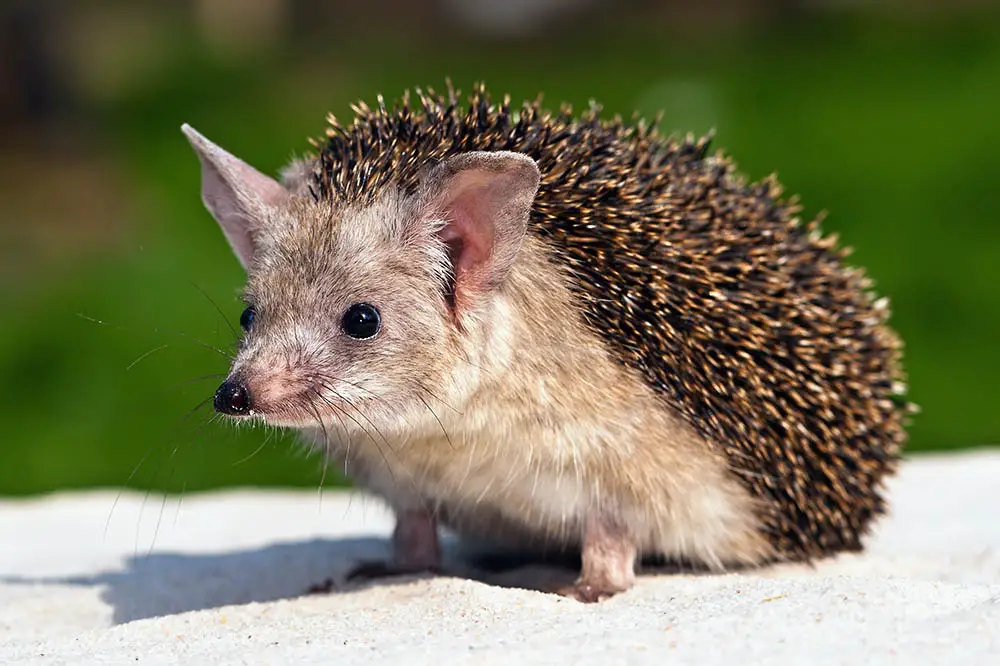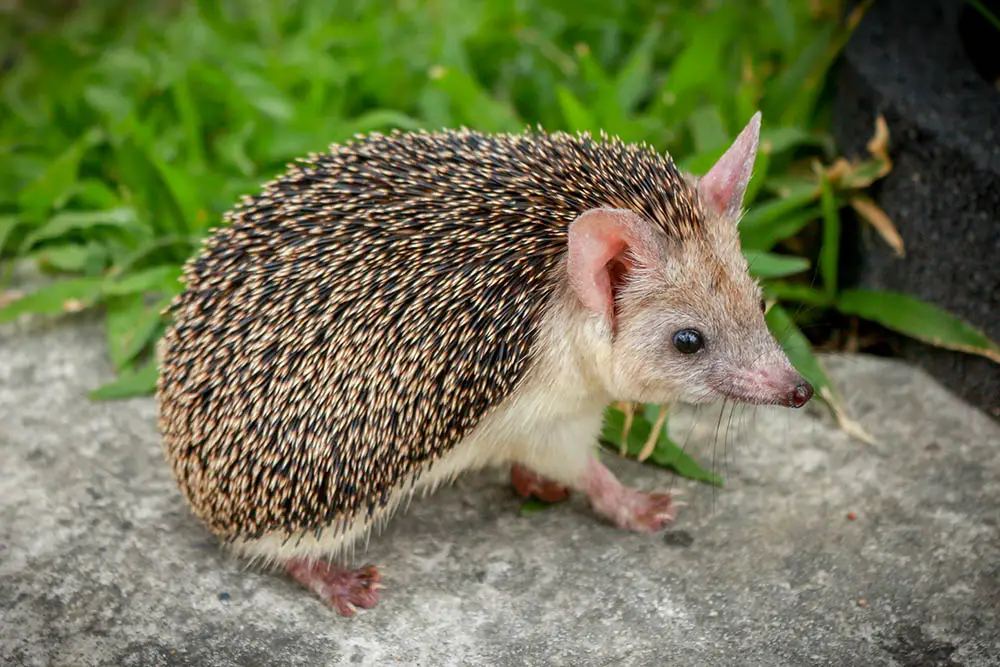There are many wonderful animals on our planet – with each species being unique in its way. And out of all these animals, hedgehogs are often overlooked in terms of their fascinating characteristics.
When you imagine a hedgehog, you probably picture a bristly brown creature with a long and pointed nose. A cute critter that spends its days foraging through the undergrowth of forests, looking for insects to eat. But did you know that some hedgehogs live in the desert?

There are seventeen recorded species of hedgehog in our world – with each variety having its unique habitat and attributes. We have created an ultimate guide that covers everything you need to know about the Egyptian hedgehog – from its habitat to its dietary requirements.
If you have ever been interested in these spiky animals before, then you can learn more about them down below.
Appearance
Hemiechinus auritus (otherwise known as the Egyptian long-eared hedgehog) is a species of hedgehog that is known to populate portions of Africa and the Middle East.
Unlike most varieties of hedgehog, this particular species is distinguished by its long ears – which have earned the creature it’s commonly used name. These elongated ears give the hedgehog a heightened sense of hearing, which it uses to hunt prey and detect predators.
When compared to the common West European species, the Egyptian hedgehog is noticeably smaller in its size and shape – with most specimens growing to a length of 120-270mm.
This particular species also weighs around 200-400 grams and is capable of running at a faster pace than most hedgehog varieties. The Egyptian long-ear is also known for its sandy hue and will typically feature a layer of pale fur along its underside.
Another distinctive feature that separates the Egyptian hedgehog from its European cousin is its spines – which are much shorter than other species.
Although the animal is equipped with a back of sharp quills, it will not curl into a ball when attacked or threatened. Instead, the Egyptian hedgehog has been known to throw itself at predators, using its spines to ward off any possible danger.
Habitat
Although the long-eared hedgehog is commonly found in Egypt, it is also native to a variety of different countries across the Middle East and Europe.
These countries include: Afghanistan, China, Cyprus, Iran, Iraq, Israel, Kyrgyzstan, Lebanon, Libya, Mongolia, Pakistan, Russia, Syria, Tajikistan, Turkey, Turkmenistan, Ukraine and Uzbekistan.
The Egyptian hedgehog is known to prefer moderate climates and will often forego the heat of the desert for more shaded and fertile surroundings. The species will often make its home in dry riverbeds and gullies, or near shrubby oases and human settlements.
When the hedgehog has found its perfect environment, it will dig a deep burrow into the earth which it will use as its home. Typically, the burrows can reach a length of 45 cm and will often be built with one opening.
The long-eared hedgehog is known to be a solitary and nocturnal animal and it will sometimes make its home in burrows that have been left behind by other mammals.
When constructing its burrow, the hedgehog will often dig beneath a bush or rock to ensure the protection and secrecy of its home. Being nocturnal creatures, the Egyptian hedgehog is known to spend its days sleeping under rock piles and hollows.
Diet
Like its various continental cousins, the Egyptian long-eared hedgehog is an insectivore – which means that its diet primarily consists of small insects. The hedgehog will primarily spend its evenings foraging for insects to consume, which can include anything from snails to millipedes.
When breaking down the long-eared hedgehog’s diet, scientists found that the species is also capable of eating birds eggs and small mammals.
Similar to other hedgehog species, the Egyptian hedgehog is also known to hunt and eat reptiles – particularly small varieties of snake. The hedgehog does this by protecting its underside as it bites the snake and slowly consumes it.

The long-eared hedgehog also prefers to make its home near a water source, so that it can stay hydrated in the heat. However, if there is no viable water source close by, the hedgehog will be able to acquire its water intake from the insects and animals it devours.
The Egyptian hedgehog remains an active animal for most of the year and will only hibernate for brief periods.
Unlike other hedgehogs, who will primarily hibernate during the cold winter months, the Egyptian hedgehog will choose to hibernate either during the winter or summer. This depends on the amount of food that is available to them during these seasons.
Reproduction
The Egyptian hedgehog will typically breed only once every year, usually during the summer season between July and September. Although the species has sharp spines on its back, this does not mean that its ability to breed is in any way impaired.
The gestation period for Egyptian hedgehogs can last 35-42 days, and the female will often give birth to 2-3 babies.
When they are first born, the hoglets will have fleshy pink skin instead of fur and will only have a small number of spines on their backs.
However, within five hours after birth, the spines will begin to double in size and new ones will begin to sprout. After two weeks, the hoglets will have their full spines and they will also be capable of consuming solid food.
In the wild, Egyptian long-eared hedgehogs are capable of surviving for six years. However, the hedgehog’s life span will be greatly threatened by the influence of predators and disease.
When kept in captivity, the Egyptian hedgehog has been known to live for up to ten years, especially when protected from large animals and given a controlled diet.
Impact
Although Egyptian long-eared hedgehogs are only small and insignificant creatures, this does not mean that they haven’t had a profound impact on Egyptian culture or the country at large.
Back in the days of Ancient Egypt, hedgehogs were widely considered to be beneficial and positive animals – with the hedgehog’s likeness being fashioned into various pieces of jewellery such as rings and amulets.
Modern historians believe that the ancient Egyptians associated the hedgehog with good luck and saw the animal as a symbol of rebirth – which may have stemmed from the creature’s hibernation pattern being mistaken for resurrection.
However, this does not mean that the Egyptians were above eating the animal as a viable food source. As there have been many ancient recipes discovered that list hedgehog as the primary ingredient.
These days hedgehogs are not considered a delicacy among the Egyptian people and are instead considered a beneficial animal to have near human settlements.
Long-eared hedgehogs are considered particularly useful for agriculture, as they are known to eat harmful pests such as termites and scorpions. The hedgehog itself is also not known to damage crops, as it will often make its home in the dry wasteland.
Can You Keep Egyptian Hedgehogs As Pets?
In recent years, hedgehogs have become popular pets among exotic animal lovers, with many being domesticated around the world. Egyptian hedgehogs are sometimes kept as pets, however, this does not mean they are a particularly easy species to domesticate.
Unlike African pygmy hedgehogs, long-eared hedgehogs can be difficult to tame and this means they can be more aggressive when kept in captivity.
However, if you are interested in purchasing an Egyptian hedgehog as a pet, there are certain things that you need to know. Down below we have outlined the positives and negatives of owning this species of hedgehog, and the various elements you will need to ensure your hedgehog’s happiness.
Housing
When purchasing an Egyptian hedgehog, it is always important to remember that they are solitary animals. So if you purchase more than one, you will have to keep them apart or risk them fighting and hurting each other.
Hedgehogs like to be active when they are awake, so you need to house them in an enclosure that can provide plenty of space. For this, you can use cages that have been designed for hamsters and rats. However, you can also use a modified aquarium if you wish.
Next, it is important to find a material that can be used to line the exterior of your long-eared hedgehog’s enclosure. It is recommended that you use something like aspen shavings or recycled paper alternatives, as these will provide soft and comfortable bedding for the hedgehog.
However, it is also wise to stay away from cedar shavings, as these have been proven toxic for some mammals. Hedgehog owners have also been known to use carpet and fabric to line their cages, but this can be dangerous as the loose threads could choke or ensnare the hedgehog.
Hedgehogs are messy creatures and they will often leave their urine and faeces throughout their cage. This means the shavings you use will often have to be cleaned out and replaced for the security of your hedgehog’s health.
You will also need to keep your hedgehog active during the night and this can be managed by purchasing an exercise wheel that can be fitted inside the animal’s enclosure.
Food
As we have previously mentioned, Egyptian hedgehogs are skilled hunters who live on a diet made up primarily of various insects. When it comes to caring for a pet hedgehog, you will have to maintain its controlled diet, which will also include a variety of insects and foodstuffs.
Because hedgehogs are nocturnal creatures, you will have to feed your Egyptian long-ear during the night when the animal will be at its most active.
The best dish for your hedgehog will typically include high-quality cat food, mealworms, crickets and dried vegetables. Mealworms are a particular favorite of most African hedgehog species, and this means you will have to keep a stock of the worms in your home.
For the best results, we recommend feeding the mealworms a diet of fruit and vegetables, as this will be more beneficial for your hedgehog when consumed.
Egyptian hedgehogs also enjoy eating crickets, and this means you can use crickets as a way to ensure your hedgehog is getting some exercise. When feeding your hedgehog, place a handful of live crickets into the hedgehog’s enclosure.
This will allow the hedgehog to hunt and forage for the living insects, keeping the animal active and providing mental stimulation. You can supply your hedgehog with water either by purchasing a water bottle with a metal tip or by placing it in a bowl inside the cage.
Health
Unlike other hedgehog species, the Egyptian hedgehog is naturally prone to parasitic attacks – which means it is capable of carrying diseases such as the plague. Because of this particular characteristic, it is advised that you purchase your long-eared hedgehog from a certified breeder with a reliable background.
Purchasing an Egyptian hedgehog from an illegal breeder could result in you and your loved ones being exposed to the various harmful diseases your hedgehog could be carrying.
Unfortunately, another health problem that is common among domesticated hedgehogs is obesity, which can greatly deter the animal’s health and physicality. Often obesity is the result of owners overfeeding their hedgehog or giving the animal too many fatty foods that should only be consumed in small quantities or as a treat.
When keeping a long-eared hedgehog as a pet, always make sure you are providing the animal with a controlled diet, otherwise, you could risk damaging the hedgehog’s health.
When keeping a hedgehog, it is important to always clean out the animal’s cage once the shavings have become too dirty. If you do not do this, then the hedgehog could become susceptible to conditions such as skin problems, ear mites and respiratory damage.
Hedgehogs as a species are also capable of exhibiting a genetic condition called ‘wobbly hedgehog syndrome’ which results in the animal having progressive paralysis. Sadly, there is no known cure for this condition and it will often result in the hedgehog’s death.
Legality
Wishing to own an Egyptian hedgehog is easier said than done, but this doesn’t mean it is completely impossible – as keeping hedgehogs as pets is still considered legal in most of the United States.
However, the activity is still considered criminal in states such as California, Georgia, Pennsylvania and New York City.
In some states, the owning of a hedgehog is completely legal, but you will need to apply for a permit or certificate of health before you can purchase one – this is the law that is implemented in places such as New Jersey and Wisconsin.
These restrictions are imposed by the United States due to hedgehogs being considered highly invasive animals when introduced to a new country.
Hedgehogs are also viewed with suspicion because the species is capable of carrying foot and mouth disease – a deadly and contagious condition that is often found in livestock.
If you wish to keep a pet hedgehog, then you must make sure that the keeping of a hedgehog is legal in your home state. If you do not, then you could risk being charged with a serious crime.
Purchase
Because Egyptian long-eared hedgehogs are native to countries across Africa, Europe and Asia – they can be difficult to purchase. However, this does not mean you should attempt to purchase an Egyptian hedgehog through illegal or criminal means.
As we have previously discussed, this species of hedgehog is highly susceptible to disease, and purchasing one illegally could result in your exposure to a deadly virus.
When purchasing any species of hedgehog to keep as a pet, it is always recommended that you go to a reputable breeder with the legal documentation needed to breed such exotic animals.
You should use a breeder who often hand raises the young hoglets, as this will make the animal more accustomed to human touch and interaction. Hoglets that are between 6-8 weeks old are also easier to tame and raise, so it is recommended that you purchase a hedgehog of that age.
Make sure that the hedgehog you are purchasing has wide eyes, clear nostrils and a healthy coat of quills and fur. This means that the hedgehog has been well cared for and is in healthy condition.
You should avoid purchasing hedgehogs that exhibit skin conditions, missing spines or oral discharge – for this could mean the hedgehog is sick or mistreated by the breeder.
The hedgehog should also be of a decent size and weight, which shows it has been fed properly. Purchasing a hedgehog in good condition means that you will have less to be concerned about when you take it home.
The average price for a young hedgehog will usually range between 75 to 250 dollars. Make sure you are not being overcharged by the breeder before completing your purchase.









